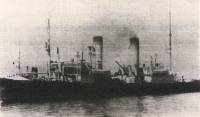Tuesday, April 10 2018
Our work on the First and Famous project has seen us identify and catalogue many different types of vessel; from the elegant to the workhorses of the ocean. One such workhorse was the icebreaker Lenin ex St. Alexandre Nevsky. Icebreakers are of vital importance to those countries locked in by sea ice for many of the winter months, such as Russia, Canada, Northern America and the Scandinavian countries. An icebreaker is specifically designed to force its way through pack ice up to a certain depth. The vessel is built with a reinforced bow and powerful engines in order to push and clear a path through the ice, usually with propellers forward as well as aft to assist this operation. Sometimes the bow is driven onto the ice to break it under the weight of the ship. Other ships can then follow the icebreaker through the lead in the ice.
St. Alexandre Nevsky was built by Armstrong Whitworth & Co. Ltd., Newcastle at their High Walker yard under LR’s special survey and launched on 23 December 1916. Our existing plans and survey reports for her include the First Entry for Steel Steamer report completed by LR surveyor Thomas Stonham Shute, which includes information as to her Master – M Nicolaieff, her Report for Machinery completed by LR surveyor Thomas Field and her profile and deck and midship section plans supplied by the shipyard. Named for Russian prince and military leader, Alexander Yaroslavich Nevsky, who was canonised in 1547, her construction was overseen by Yevgeniy Zamyatin, a Russian engineer and author, who was sent to the UK in 1916 to supervise the building of the icebreakers Sviatogor (later Krasin) and St. Alexandre Nevsky at Newcastle. The vessel was to be registered at Vladivostok and the reports also indicate that her triple expansion steam engines, driving three propellers, one forward and two aft, developed a nominal horsepower of 1,142. St. Alexander Nevsky was following a tradition of icebreakers built at the Armstrong Whitworth yard. Her predecessor, the Ermack, the first icebreaker to have an ice strengthened hull form specifically designed to ride over and crush ice, was launched by the same shipbuilder in 1898.
The vessel was classed by LR in 1917 but due to the Russian February Revolution, the vessel was taken over by the Royal Navy when completed that year and commissioned as HMS Alexander, serving in the North Russia campaign before being handed over to Russia in 1919. By 1921 she had been renamed Lenin after Vladimir Lenin, the Russian politician and communist revolutionary. This same year the Lenin undertook an experimental voyage through the Kara Sea, part of the Northern Sea route, together with five merchant ships, under the command of Norwegian captain and explorer Otto Sverdrup, who had commanded Fridtjof Nansen’s vessel Fram. Having reached the rivers Ob and Yenisei the vessels returned safely and the voyage was declared a success.
Lenin remained in class with LR until December 1923. During World War II Lenin took part in the Russian Arctic Convoys and in 1942 was part of a convoy in the Kara Sea spotted by a German reconnaissance aircraft. Alerted, the German heavy cruiser Admiral Scheer raced to the area to seek and destroy the convoy, but the weather closed in and the convoy was able to avoid destruction due to the thick fog, ice and bad weather.
Having survived the war, Lenin was reclassed by LR in 1948 and resumed her peacetime duties. In 1957, with the launch of the new Soviet nuclear icebreaker, Lenin, she was renamed Vladimir Ilich Lenin. She continued in service until reduced to a hulk from 1968 and then she was broken up in 1977. Her replacement has now also retired and is permanently on display as a museum ship moored at Murmansk.
To learn more about the Lenin and view documents relating to her, click here.





